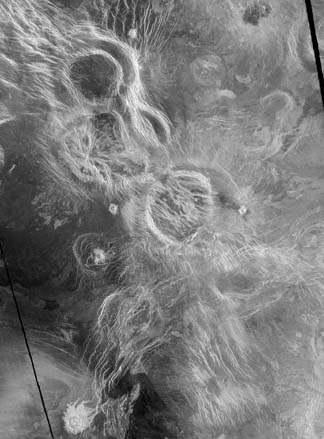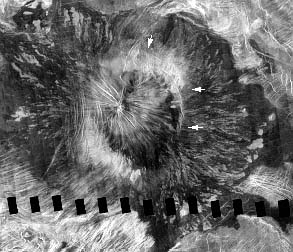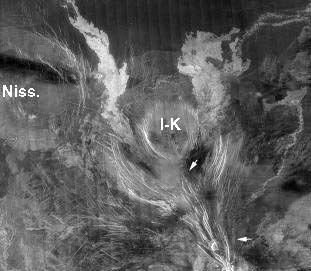Corona Chain

Many coronas lie in groups or chains. Here, we see one such grouping of 4 or 5 coronas about 200 to 250 km across. It is part of a much longer chain over 4000 km long. The coronas overlap in places, but they are also linked by a number of bright faultlines. These faults are part of a major rift zone, Parga Chasma, that seems to have helped the coronas form. Indeed, the Parga rift has the highest density of coronas to be found on Venus. It also runs into Atla Regio and may have helped to feed the large shields found in that region. Thus, while rifts can bring lavas to the surface, this rift may also lie over a line of deeper mantle melting and uplift.
(Image is part of Magellan C2 MIDR 30S284, centered near 34S, 275E.)
A Simple Arachnoid

This arachnoid lies in the plains northwest of Atla Regio. Like a Corona, it has a clear fault ring and a central (mostly) smooth region. Unlike a Corona, it also has a set of radial ridges which arc away from the fault ring. It is also much smaller than most coronas. In this case, the fault ring is about 95 km across, and most arachnoids are about the same size. In contrast, most coronas are over 200 km across. Still, outside the fault ring, the ridges seem to run 100 to 200 km before merging with other ridge systems.
Most arachnoids show few signs of volcanism. Here, there are a few small
shields in the center, but the plains lavas show the clearest signs of volcanism. Note
the bright lava flows on the northwest and southeast that seem to come out of the
fault ring. Also note how the dark plains arc above the arachnoid, and how they
ring the crater in the bottom center (arrows). These all suggest that many large, thin
lava flows were erupted as the arachnoid was forming.
(Image is part of Magellan C1 MIDR 45N223, centered near 41N, 214E.)
Complex Arachnoids

Arachnoids often lie in faulted plains, and their outer ridges tend to turn into regional patterns. Thus, they often look like spiders on a bright web. Indeed, the name Arachnoid means Rspider-likeS. Here, we see two arachnoids in a faulted plains region (A and B). These features are each about 120 km across, with an outer ring of ridges maybe 150 km wide. Again, there is little sign of volcanism. Only a few bright lava flows are seen in the upper left. A third feature (C) may also be an arachnoid. However, it has only a few radial ridges, and it also shows a caldera-like pattern of nested cliffs. Thus, it is harder to classify. The edge of a larger corona (arrows) also can be seen at the top of the image.
(Image part of Magellan C1 MIDR 45N011, centered near 40N, 19E.)
Simple Nova

Unlike Coronas and Arachnoids, Novas do not have major ring features. Rather, they show a striking starburst of faults and graben. Also, there is often a clear rise at the center of these faults. This example is some 250 km across, and it lies in Themis Regio. There is no clear sign of volcanism, but a few small lava flows may run out from faults in the upper left and upper right. Still, there is a lot of volcanism nearby. Namely, this nova lies within a very long chain of coronas. Indeed, it lies just above the corona chain image in Parga Chasma. Novas mostly occur next to large shields or major corona chains. Thus, they seem to be volcanic. They probably mark an early stage of uplift and faulting that could later become a corona or a large shield volcano.
(Image is part of Magellan C1 MIDR 30S279, centered near 27S, 272E.)
Transitional Form

This image may show the future of other novas on Venus. It shows a complex volcano with several clear parts. Its raised center has a clear starburst of nova-like faults. Around this nova is a partial ring of corona-like faults (arrows). Then, outside the corona, is a broad apron of thin bright lava flows. These flows lie on darker lavas which, in turn, clearly bury a much older area of heavily faulted lowlands. In all, the outer lava flows mark the start of a shield volcano some 450 km long by 350 km wide. The central nova itself is about 150 km across. Maybe, in 10 or 50 million years, more flows will finally bury the central nova to make a shield looking like Ushas Mons.
(Image part of Magellan C1 MIDR 15S215, centered at 15S, 215E.)


 To VolcanoWorld
To VolcanoWorld